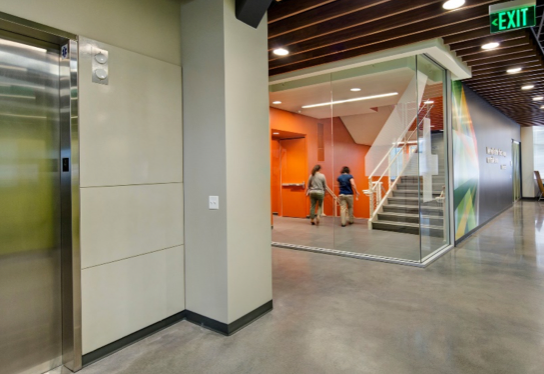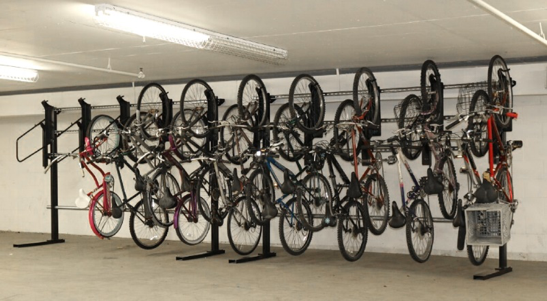|
|
Student Corner: 5 ways to make your building healthier: Fitwel, Part 2 of 2By CED Program Interns & StudentsPublished June 6, 2017
What does a ‘healthy’ building look like? 1. Encouraging Use of the Stairs Office stairwells usually look like this: Unattractive, empty, and tucked away to the corner of a building, these stairwells are unpleasant to use. People instead take the elevator, and this hurts their health: just two minutes of stair climbing each day is enough to prevent average, middle-age weight gain. To increase occupants’ physical activity, consider posting signs near elevators to promote stairwell use. Where possible, also consider locating stairwells in areas that are at least as visible as any elevators or escalators at the main entrance. The following best practices in design can also help usher people toward the stairs:
2. Indoor Air Quality Policy Indoor air pollutants are generally 2 to 5 times greater than outdoor pollution levels and, in some cases, 100x greater, according to the EPA. Beyond the basics (no asbestos, no smoking indoors), Fitwel rewards office buildings that adopt and implement an Indoor Air Quality (IAQ) policy. An IAQ identifies areas for improvement and provide benchmarks to measure progress against to ensure that quality remains high over time. An IAQ policy requires finishes, furniture, and other building products that produce little to no harmful odors 3. Encourage Biking By providing employees with secure bicycle parking and on-site showers and lockers, an office building can increase the appeal of cycling to work, which in turn increases levels of physical activity. Bike parking should be secure, covered, within 100 feet of a building entrance, and provide spots for at least 5% of regular building occupants (or less if an occupant survey calls for it). Showers with lockers may also increase the appeal of walking, running, or biking to work. They should be provided for a minimum of 1% of regular building occupants (or less, per a survey). 4. Lactation Rooms A dedicated lactation room is a simple solution that offers numerous benefits. It increases worker productivity while decreasing health claims and absenteeism to care for sick children. To earn Fitwel recognition, a lactation room should be a place – other than a bathroom – shielded from view and free of intrusion from coworkers and the public. It should also have an electrical outlet, lactation station, refrigerator, and sink. 5. Improved Workspaces In addition to recognizing active workstations, such as treadmill desks, Fitwel rewards buildings that offer natural daylight and views to the outside for most their workspaces. Previous blogposts discuss the benefits of this exposure, also referred to as biophilic design. Luke Patton is a recent graduate of the UNC Kenan-Flagler Business School and was a Fellow with the Development Finance Initiative. |
Published June 6, 2017 By CED Program Interns & Students
 A recent CED blog post introduced Fitwel – a new certification system focused on occupant health and wellness in buildings – and began to explore what a ‘healthy’ building looks like. This post continues the discussion, highlighting five examples of features that the Fitwel system recognizes. The purpose of this post is to give readers a better sense of:
A recent CED blog post introduced Fitwel – a new certification system focused on occupant health and wellness in buildings – and began to explore what a ‘healthy’ building looks like. This post continues the discussion, highlighting five examples of features that the Fitwel system recognizes. The purpose of this post is to give readers a better sense of:
- what Fitwel certification looks like in practice; and
- what specific things owners and tenants can do to make their office buildings healthier places to work.
What does a ‘healthy’ building look like?
1. Encouraging Use of the Stairs
Office stairwells usually look like this:
Unattractive, empty, and tucked away to the corner of a building, these stairwells are unpleasant to use. People instead take the elevator, and this hurts their health: just two minutes of stair climbing each day is enough to prevent average, middle-age weight gain.
To increase occupants’ physical activity, consider posting signs near elevators to promote stairwell use. Where possible, also consider locating stairwells in areas that are at least as visible as any elevators or escalators at the main entrance. The following best practices in design can also help usher people toward the stairs:
- Placing a window or skylight in the stairwell
- Using materials within the stairwell that are of no less quality than those in adjacent hallways
- Increasing stairwell visibility with code-compliant glass
2. Indoor Air Quality Policy
Indoor air pollutants are generally 2 to 5 times greater than outdoor pollution levels and, in some cases, 100x greater, according to the EPA. Beyond the basics (no asbestos, no smoking indoors), Fitwel rewards office buildings that adopt and implement an Indoor Air Quality (IAQ) policy. An IAQ identifies areas for improvement and provide benchmarks to measure progress against to ensure that quality remains high over time. An IAQ policy requires finishes, furniture, and other building products that produce little to no harmful odors
3. Encourage Biking
By providing employees with secure bicycle parking and on-site showers and lockers, an office building can increase the appeal of cycling to work, which in turn increases levels of physical activity. Bike parking should be secure, covered, within 100 feet of a building entrance, and provide spots for at least 5% of regular building occupants (or less if an occupant survey calls for it). Showers with lockers may also increase the appeal of walking, running, or biking to work. They should be provided for a minimum of 1% of regular building occupants (or less, per a survey).
4. Lactation Rooms
A dedicated lactation room is a simple solution that offers numerous benefits. It increases worker productivity while decreasing health claims and absenteeism to care for sick children. To earn Fitwel recognition, a lactation room should be a place – other than a bathroom – shielded from view and free of intrusion from coworkers and the public. It should also have an electrical outlet, lactation station, refrigerator, and sink.
5. Improved Workspaces
In addition to recognizing active workstations, such as treadmill desks, Fitwel rewards buildings that offer natural daylight and views to the outside for most their workspaces. Previous blogposts discuss the benefits of this exposure, also referred to as biophilic design.
Luke Patton is a recent graduate of the UNC Kenan-Flagler Business School and was a Fellow with the Development Finance Initiative.
Author(s)
Tagged Under
This blog post is published and posted online by the School of Government to address issues of interest to government officials. This blog post is for educational and informational Copyright ©️ 2009 to present School of Government at the University of North Carolina. All rights reserved. use and may be used for those purposes without permission by providing acknowledgment of its source. Use of this blog post for commercial purposes is prohibited. To browse a complete catalog of School of Government publications, please visit the School’s website at www.sog.unc.edu or contact the Bookstore, School of Government, CB# 3330 Knapp-Sanders Building, UNC Chapel Hill, Chapel Hill, NC 27599-3330; e-mail sales@sog.unc.edu; telephone 919.966.4119; or fax 919.962.2707.




